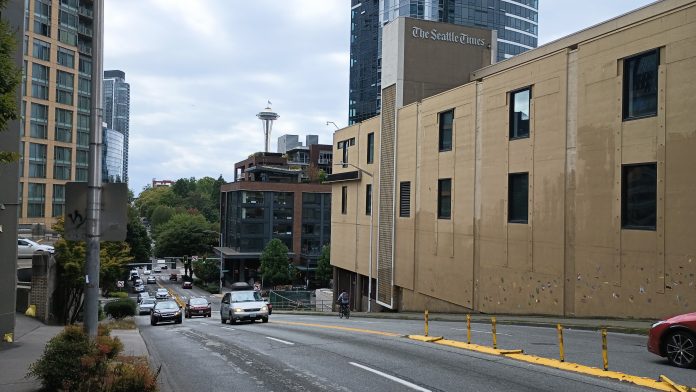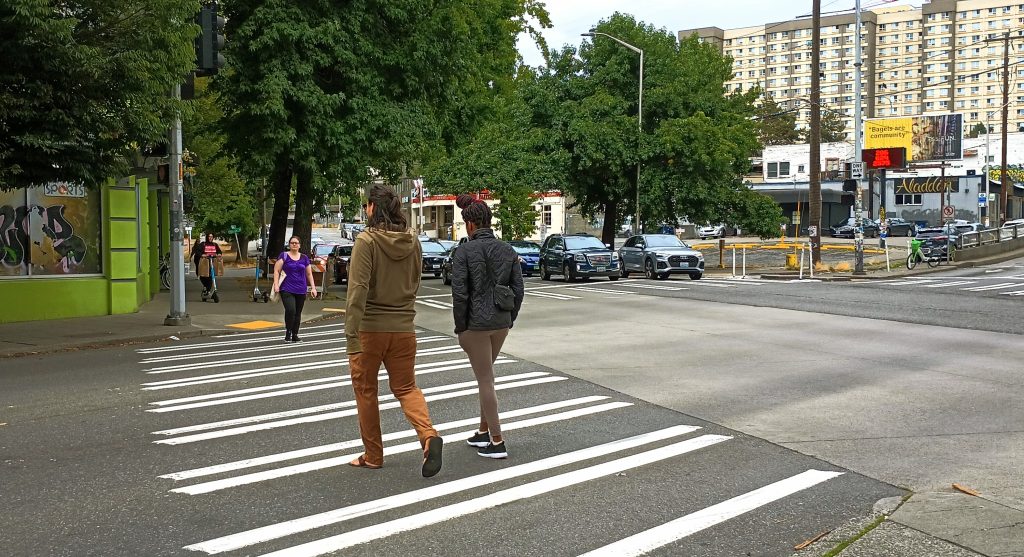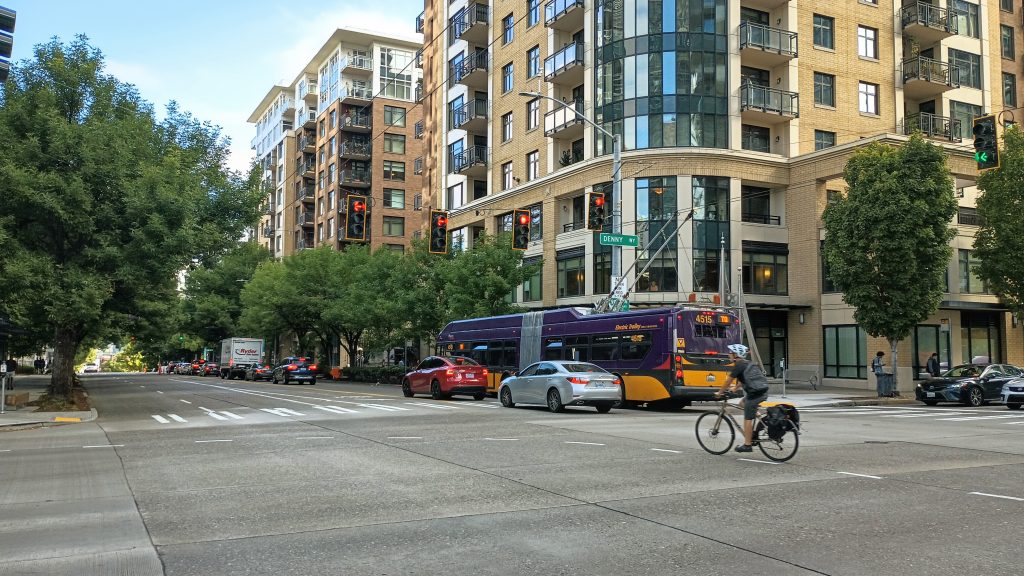
SDOT considered a laundry list of improvements, but most aren’t moving forward.
As soon as next year, the Seattle Department of Transportation (SDOT) will start construction on a major repaving project along one of the city’s most congested streets, Denny Way. The pavement maintenance project will target the street’s busiest segments, starting just east of 5th Avenue N extending all the way to I-5’s front door at Stewart Street and including a short stretch of Yale Avenue which drivers use to get onto the highway. The $5.05 million project, one of the last major corridor repavings planned under the Move Seattle Levy set to expire next year, will also repair some sidewalks, rebuild substandard curb ramps, and make some other minor street changes intended to improve safety.
But Denny Way, which carries around 33,000 vehicles per day at its busiest point east of Westlake Avenue N, will be repaved and restored in basically the same configuration that it exists in today. That decision passes on a chance to take advantage of the major work along the corridor to advance some of the city’s goals around safety, mobility, and climate. With Move Seattle Levy repaving projects adding bike lanes to streets like Green Lake Way N or space for transit in the case of Delridge Way SW, Denny Way maintaining two general purpose lanes for most of it length after repaving will be an outlier.

Over the past year, a similar business-as-usual approach to repaving 15th Avenue NW through the heart of Ballard received attention from advocates, who successfully lobbied the city to broaden the scope of the project to include more safety elements. Now planned are a new pedestrian crossing, a planted median intended to slow vehicle speeds, and a new bus lane. SDOT Director Greg Spotts touted the fact that the department would no longer be “locking in an outdated street design” with that project when he announced the changes in July.
SDOT project managers recently signed The Denny Way project’s Complete Streets Checklist at the end of August. The checklist details a laundry list of different improvements and modifications that were considered for the stretch of roadway as the department does the repaving work, many of which aren’t moving forward. Buried deep in the document is a clear-eyed recognition that keeping Denny Way the way it is today might not be in line with the city’s broader goals.
A segment of the report notes a recommendation from SDOT’s Vision Zero that the department should look at how the street functions. “Consider lane reductions/road diet: There is a large opportunity to transition this area which is quickly densifying from a through route into something more that fits in with our big picture for Vision Zero. Think of designing for how we want our city to operate, not accommodating how it currently operates. A road diet could provide potential for bus lanes and/or medians that would could create some ped friendly crossings at the unsignalized locations and slow traffic speeds.”

The response from the SDOT division tasked with keeping traffic flowing? This isn’t the right time to take that broader look. The traffic operations division pointed to the Denny Way Intelligent Traffic Signal (ITS) project, which invested $12 million in modernizing signals to allow for the efficient flush of car traffic, as a reason to not make safety upgrades.
“[SDOT’s Traffic Operations Division is] not supportive of channelization changes at this time given recent investments in the signal infrastructure as part of Denny ITS project; Need to monitor the effect/improvement of the Denny Way ITS project and wait for traffic to normalize to understand the new baseline before evaluating additional operational changes on the corridor; Pending decisions for light rail station location and Harrison Street Transit Corridor may affect operational needs on Denny Way; Including in Denny Way [repaving] design poses a risk to schedule and grant funding requirements; No funding currently identified.”
The Denny Way ITS project, expected to wrap up this fall, will be converting signals along the entire corridor into the same “adaptive” system that is currently active on Mercer Street. Last month, SDOT confirmed to The Urbanist that the full adaptive system on Denny Way will not be activated until results from a pilot project using similar technology in the U District neighborhood are analyzed. But ultimately, the driving force behind adding the adaptive signal technology to Denny Way is to improve vehicle flow along the street, particularly after events at Climate Pledge Arena.
Signal upgrades along the street are a key element of the 2019 North Downtown (NoDo) Mobility Action Plan, which codified a number of transportation improvements that would further some of the arena’s transportation goals, which included safe bike access to the facility and dedicated space to keep buses moving in Uptown, but also limited delays during the “flush” of event traffic from the multiple garages serving the arena. The “normalized” traffic volumes that the department will be waiting on will likely increase with the use of adaptive technology.
Meanwhile, Denny Way’s frequent bus, the Route 8, has seen its rate of on-time performance steadily decline as traffic has returned to the city’s streets in recent years, with an even sharper decline noticeable since the May 1 implementation of Amazon’s most recent return-to-work policy: in August, just 49% of trips arrived within five minutes of their scheduled time during the 3pm to 7pm hours on weekdays. A short stretch of bus lane between Fairview and Stewart Street installed in 2018 will remain in place after repaving, but an extension further west doesn’t receive further consideration in the Complete Streets checklist.
Crash-Prone Intersection Set to Be Maintained

The checklist offers other insights into how traffic flow wins out over safety. It notes that the intersection of Denny Way and Fairview Avenue N ranked high, in the top 100 intersections across the city, in the city’s broad analysis of safety for active transportation users, called the Bicycle and Pedestrian Safety Analysis (BPSA).
“The collision patterns show that angle collisions, sideswipes, and right turning collisions are the most prominent types seen. Due to these collision patterns and prioritization ranking, the Vision Zero group encourages the Denny Way AAC project to strongly consider rechannelization on Fairview legs to allow one through lane in each direction,” it states.
That recommendation will also not be moving forward.
“[The traffic operations division] considered these modifications as a part of the RapidRide J Line which will be installing [Business Access and Transit] lanes [northbound] and [southbound] on Fairview Ave,” the response reads. “TOD did not support ‘right turn only, except transit’ treatment on the SB approach given the limited merging distance between Denny Way and Virginia St.” The RapidRide J project won’t be fully wrapped up until 2026 or 2027; for now the intersection will be kept as dangerous as it is right now.
The Denny Way repaving will be putting in place the infrastructure that would be needed to add new pedestrian crossings at two intersections where crossing is very dicey for pedestrians: Boren Avenue N and 8th Avenue N. However, it won’t fund the new signals themselves. The project will also be adding paint-and-post curb bulbs to reduce pedestrian crossing distances at some major intersections, like 9th Avenue N and Boren Avenue. But for the most part, the opportunities afforded by the major repaving project were left by the wayside.
Tight Schedule and Funding Restrictions Cited
Denny Way’s repaving is funded in part by a grant from the Federal Highway Administration via a 2021 coronvirus response bill. That funding must be “obligated” by the city by August 15 of next year. Constraints from both the funding source and the timeline were cited by the city when it comes to keeping the project scope narrow. But the project didn’t exactly creep up on the city, first appearing on an SDOT webpage devoted to its major repaving program in 2020.
“This project is a federally funded preservation project and Levy to Move Seattle deliverable with firm schedule milestones,” SDOT spokesperson Mariam Ali told The Urbanist. “Apart from operational factors, the project schedule is another driving factor. Essentially, all the work involved in rechannelization, including analysis, outreach, design, and implementation, requires more time than we have due to funding and schedule constraints.”
Ali pointed to the long-term vision that SDOT is developing right now as a potential avenue for making more substantive changes to Denny Way.
“The Seattle Transportation Plan (STP) and subsequent transportation funding plan may present an opportunity to develop and implement a more holistic redesign of this critical corridor, should a major capital project on Denny Way be identified, prioritized and funded,” Ali said. “Any recommendations from the Denny Way AAC Complete Streets Checklist that are not able to be incorporated at this time could be considered for a future capital project, including potential implementation of bus lanes or freight-and-bus (FAB) lanes.”
But leaving behind a big opportunity that’s at our doorstep now doesn’t engender a lot of hope in lofty plans to be able to lead the city toward its goals. If now is not the time to “think of designing for how we want our city to operate, not accommodating how it currently operates,” when will it be?
Ryan Packer has been writing for The Urbanist since 2015, and currently reports full-time as Contributing Editor. Their beats are transportation, land use, public space, traffic safety, and obscure community meetings. Packer has also reported for other regional outlets including BikePortland, Seattle Met, and PubliCola. They live in the Capitol Hill neighborhood of Seattle.

